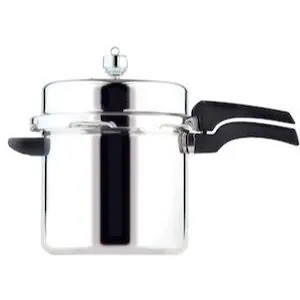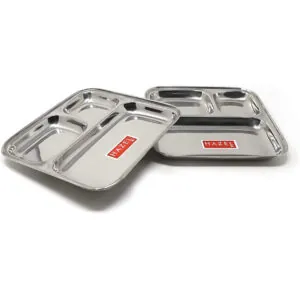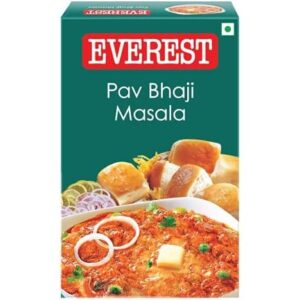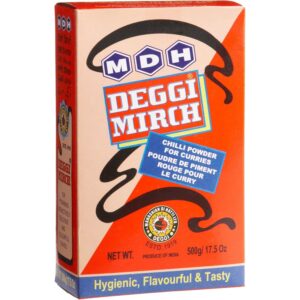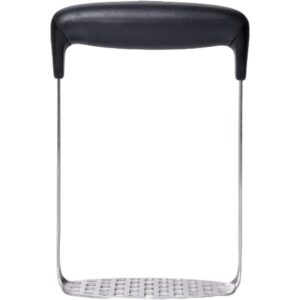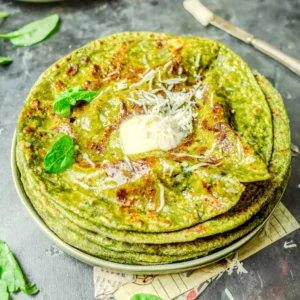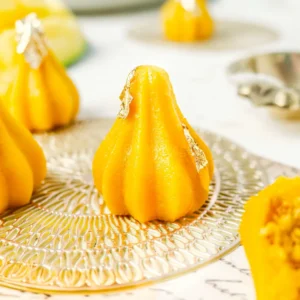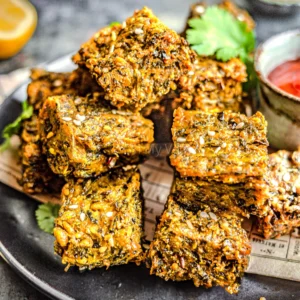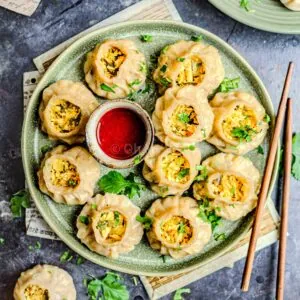Paneer Pav Bhaji
The classic Mumbai street food has been upgraded. Meet paneer pav bhaji: creamy cubed paneer tossed in a hearty mix of spiced and mashed vegetables, topped generously with grated paneer, then served alongside irresistibly buttery pav.
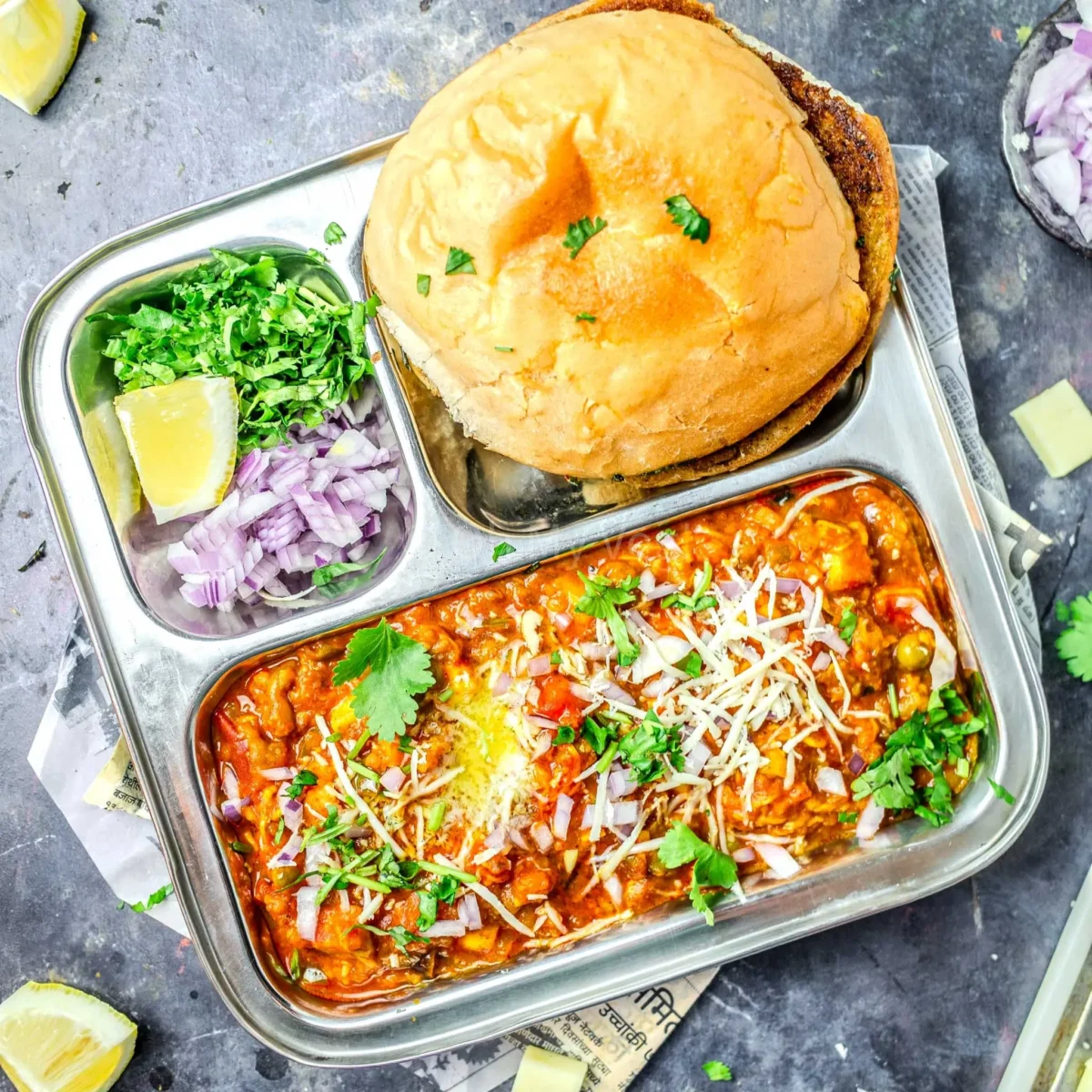
It’s not an exaggeration to say Mumbai street food is ALL about pav (bread rolls).
When you arrive by train at the imposingly gothic Chhatrapati Shivaji Terminus, the first thing you’re greeted with is the quintessential vada pav stalls. Deeper in the city, you can find street cards peddling bun samosa and crispy kanda bhaji piled inside pav. In Dadar, the heart of traditional Maharashtrian food beats through homely joints serving steel platters of scarlet-red misal pav.
Then there’s pav bhaji — perhaps the most iconic of all. Buttery bread rolls sizzle on a huge, smoking hot tawa. Mounds of aromatic, slow-cooked vegetables on either side. And more butter, for good measure. That’s Mumbai on a plate.
Paneer pav bhaji is my slightly indulgent (who am I kidding … very indulgent) take on that street food classic.
The base stays true to tradition: a wholesome mash of potatoes, cauliflower, carrots and peas, simmered with bell peppers, tomatoes, pav bhaji masala, and a dollop (or two) of salty butter.
Then comes the twist: golden chunks of fried cheese — Indian paneer — stirred right in, soaking up all those spices. It’s never enough to have just one helping of paneer, so I grate heaps of creamy paneer in at the end, too.
Needless to say, once you’ve tried paneer pav bhaji, there’s no looking back!
❓What is Paneer Pav Bhaji?
Let’s break down the name first. In Marathi, paneer refers to fresh pressed cottage cheese, pav means the soft, fluffy bread rolls, and bhaji translates to vegetable — or more specifically here, a spiced vegetable curry.
Paneer pav bhaji, then, is a modern riff on the iconic Mumbai street food pav bhaji: a richly spiced mash of vegetables served with buttered bread rolls. In this variation, paneer is stirred through the curry — whether cubed, crumbled, or grated.
😍 Reasons To Make Paneer Pav Bhaji
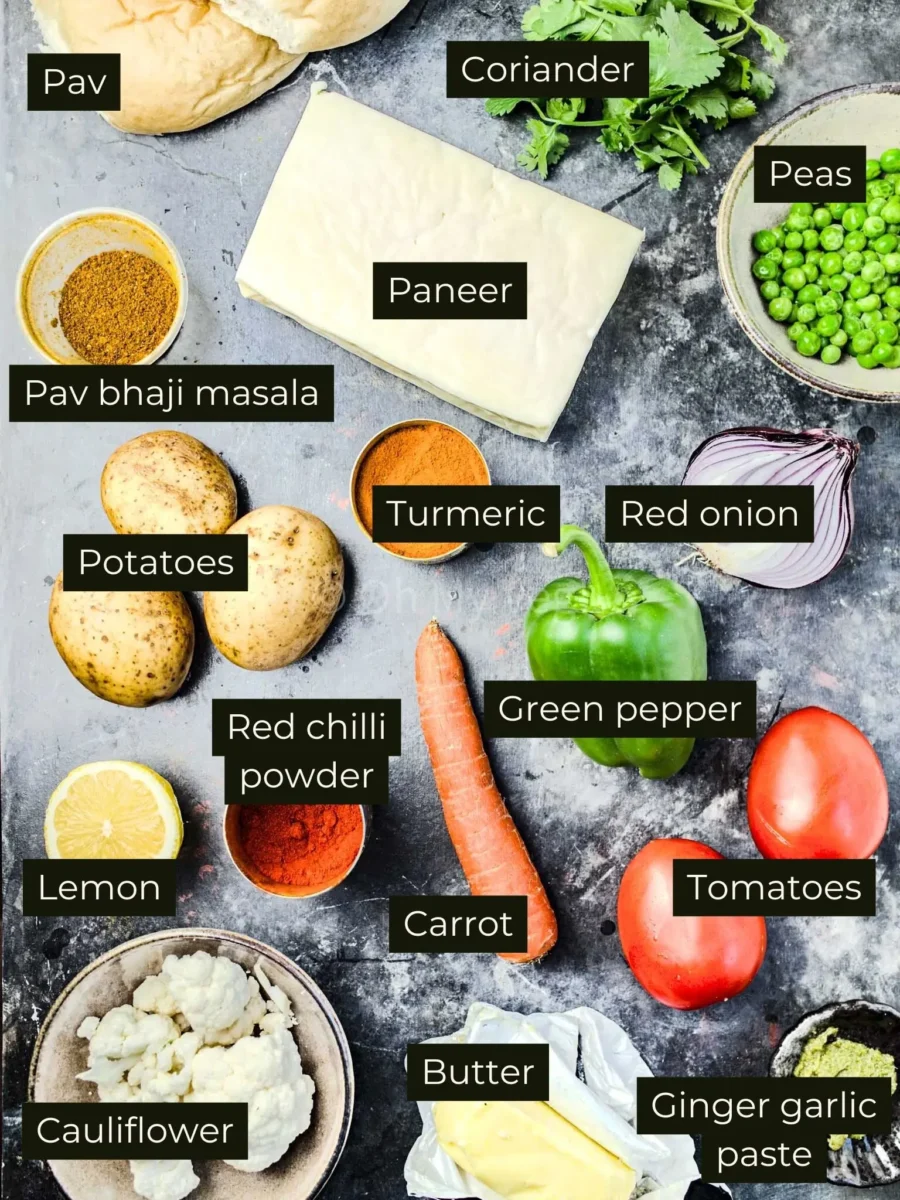
🥘 What is Paneer Pav Bhaji Made Of?
Great question! Here’s what you’ll need to make that signature, buttery, tawa-style bhaji at home:
- Paneer: An extremely mild Indian cheese sold in soft and creamy blocks. Use homemade (the best!) or fresh packets with a white colour, soft texture, and no strong smell.
- Mixed vegetables: You’ll need potatoes, cauliflower, carrots, peas, and tomatoes. This combination makes a robust, earthy, tangy, and slightly sweet mash.
- Onions: Red or yellow, either is fine — these are our savoury base.
- Ginger garlic paste: Buttery and punchy. I recommend making ginger garlic paste fresh at home whenever possible. It’s simple, fast, and doesn’t have the acidic aftertaste of store-bought.
- Green bell pepper (capsicum): Slightly bitter and very fresh tasting.
- Pav bhaji masala: Essential for that signature flavour! Make it at home or buy a pre-made mix at any Indian store.
- Chilli powder: I use deggi mirch, which has the best combination of vibrant red colour and beautiful warm heat. Use Kashmiri chilli powder for a milder bhaji or standard red chilli powder for a spicier dish.
- Turmeric powder: For colour and earthiness.
- Butter: The more generous you go with this one, the more authentic the street food vibe! I like West Country or Irish butter, but Amul is the popular Indian choice.
- Lemon: To cut through the spice with a sharp, acidic hit.
- Toppings: You’ll need citrusy coriander leaves (cilantro) and more red onion.
- Pav: India’s answer to the soft dinner roll. Authentic pav are unbeatable, but if you don’t have a local Indian bakery, swap it out for any soft white rolls, white bread slices, burger buns, or even fluffy naan.
❗Unlike most street food joints, this paneer pav bhaji recipe is free from artificial food colouring. While red food colouring is typically made from either insects (therefore not vegetarian) or petroleum by-products, this recipe relies purely on the vibrant red colour of natural chillies.
🌿 Adapting the Dish for Allergies and Dietary Requirements
This paneer pav bhaji recipe is 100% nut free, soy free, and vegetarian.
You can easily make it vegan (and dairy free) by using firm tofu instead of paneer and dairy-free butter. Firm tofu has a very similar texture to paneer and takes on flavours in much the same way, making it an incredible substitute.
Making pav bhaji gluten free is as simple as using gluten free pav (bread rolls). Most major supermarkets should stock a wide variety, giving you plenty of choice.
Finally, make a Jain version of paneer pav bhaji by skipping the onion and garlic. Instead of ginger garlic paste, use a pinch of asafoetida (hing) to mimic the flavour.
🌶️ Fun Little Variations You Might Enjoy
Paneer pav bhaji may already be a twist on the classic, but there’s still room to play. With a few simple swaps or additions, you can put your spin on it!
Here are a few of my favourite ideas! We’ve got crowd-pleasing options and for the experimental amongst you, a few wackier choices, too:
- Cheesy street-style paneer pav bhaji. Yes, paneer is cheese. But it’s not cheesy, you know? It lacks that gooey, melty essence. So, why not stir through some meltable grated cheese at the end? Choose Amul for the full street food experience, cheddar for a bold flavour, or mozzarella for the ultimate stringy meltability.
- Paneer tikka pav bhaji. Pre-marinate your paneer with spiced yoghurt mixture, then grill or char before adding to the mashed vegetables. This is spice on spice, and it’s fabulous.
- Extra vegetables. Try beetroot (to amp up the red colour) or mushrooms for a unique umami, meaty hint not usually found in pav bhaji. Although beetroot can be boiled and mashed, simply fry the mushrooms with the bell pepper.
- Increase the spice level. To up the ante, add the standard amount of chilli powder, plus an extra-hot blend — or, if you’re brave, stir through a teaspoon (or a dash) of fiery Mr Naga pickles. Be warned, this is some serious blow-your-socks-off heat!
- DECREASE the spice level. Traditionally, like most Maharashtrian recipes, pav bhaji is a hot dish. But if you have a low spice tolerance, you deserve to enjoy the dish too! Just swap deggi mirch for Kashmiri chilli powder, or, for even milder heat, paprika.
That gives you enough options to have a distinctly different plate of paneer pav bhaji every weekday! Just kidding … but it’s a great way to stay out of a cooking rut.
🧑🍳 How to Make Paneer Pav Bhaji (Step-by-Step Photos)
From chopped vegetables to buttery buns … in only a few easy steps! Let’s see how the dish comes together:
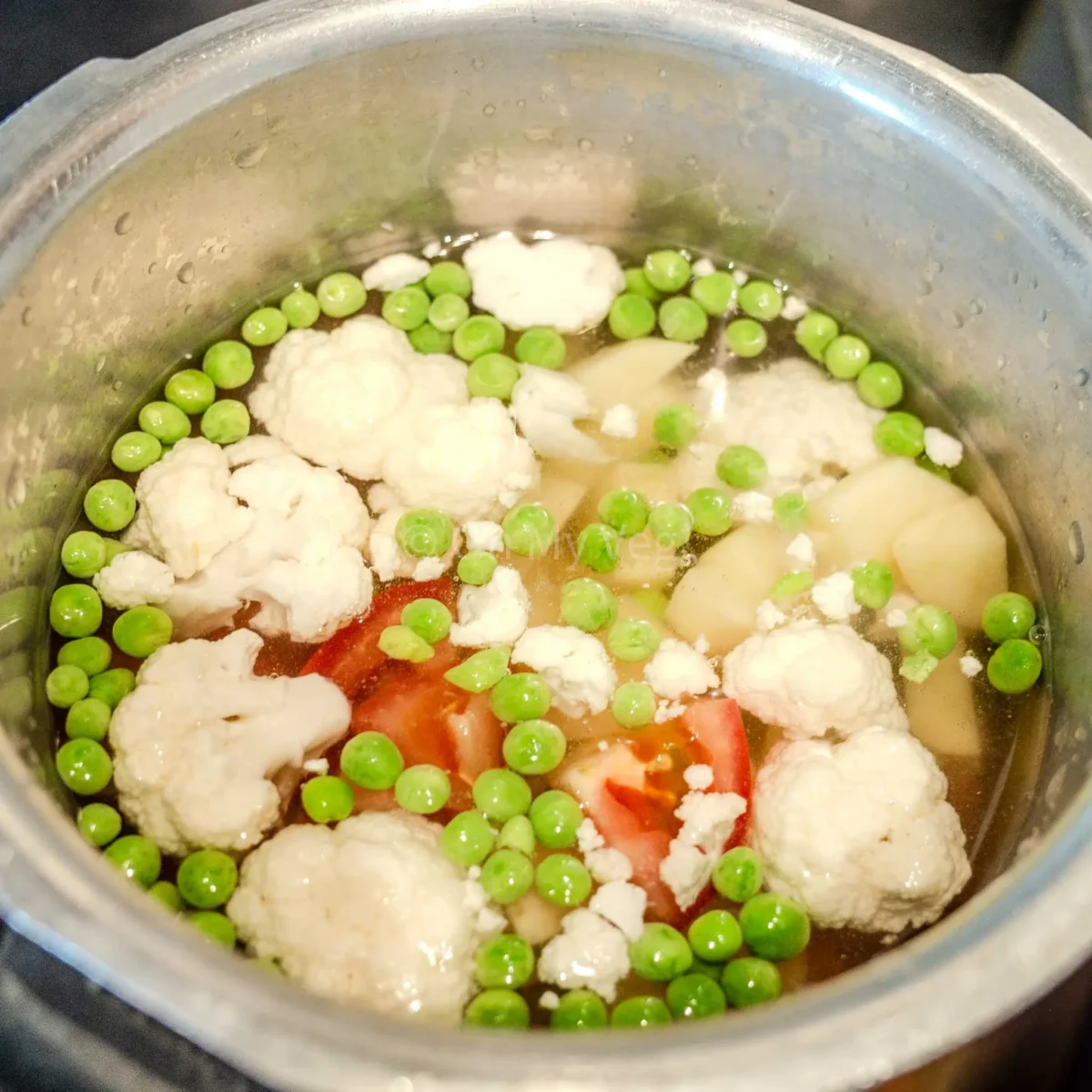
One: Bring water, potatoes, cauliflower, tomatoes, peas, and carrots to a boil.

Two: Pressure cook the mixture until soft and mushy (3 whistles), then mash.
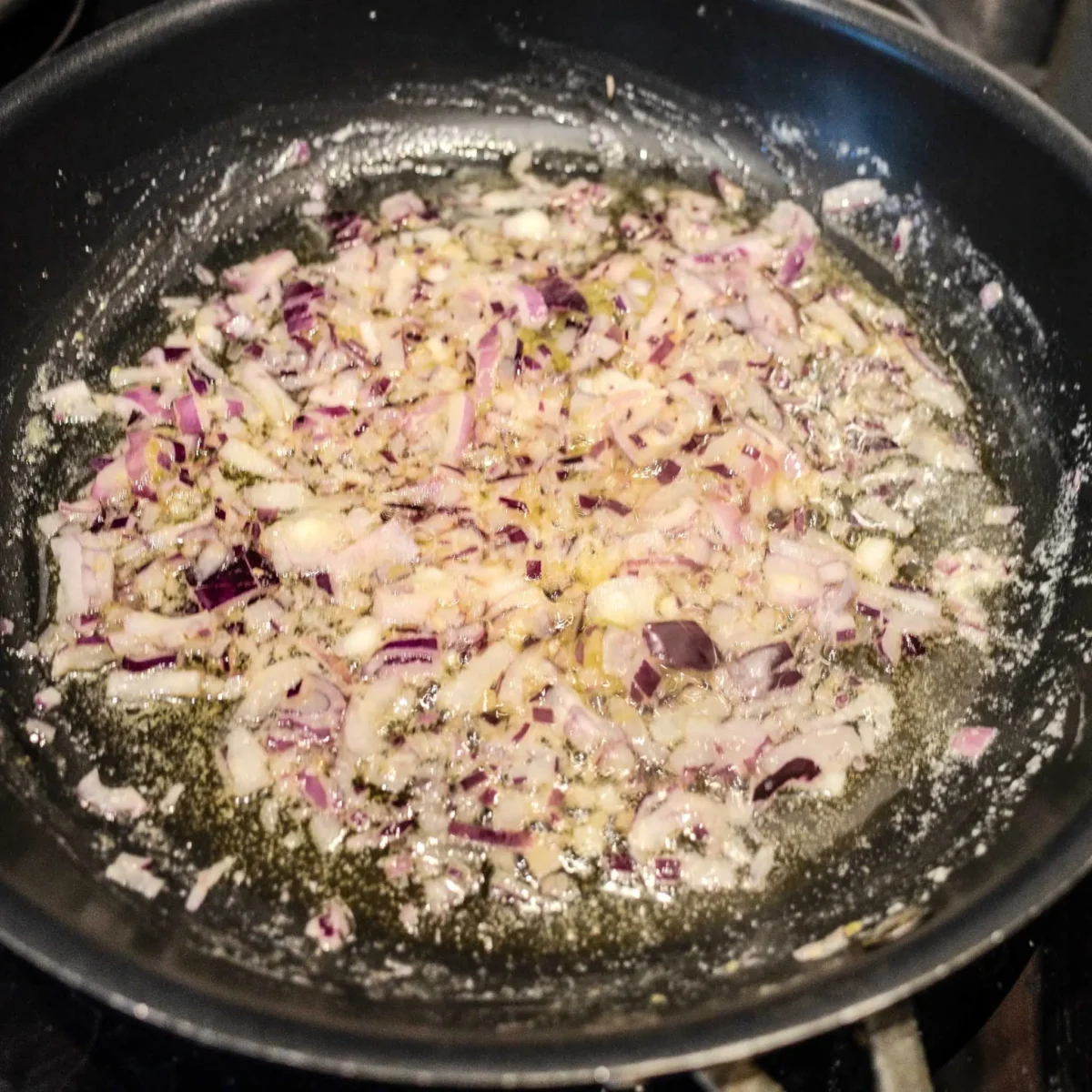
Three: In a large pan, heat butter. Fry off your onions and ginger garlic paste.

Four: Add the chopped green bell peppers and cubed paneer.

Five: Gently fry until the paneer slightly browns and bell peppers soften.

Six: Add the pav bhaji masala, turmeric powder, deggi mirch, and red chilli powder.
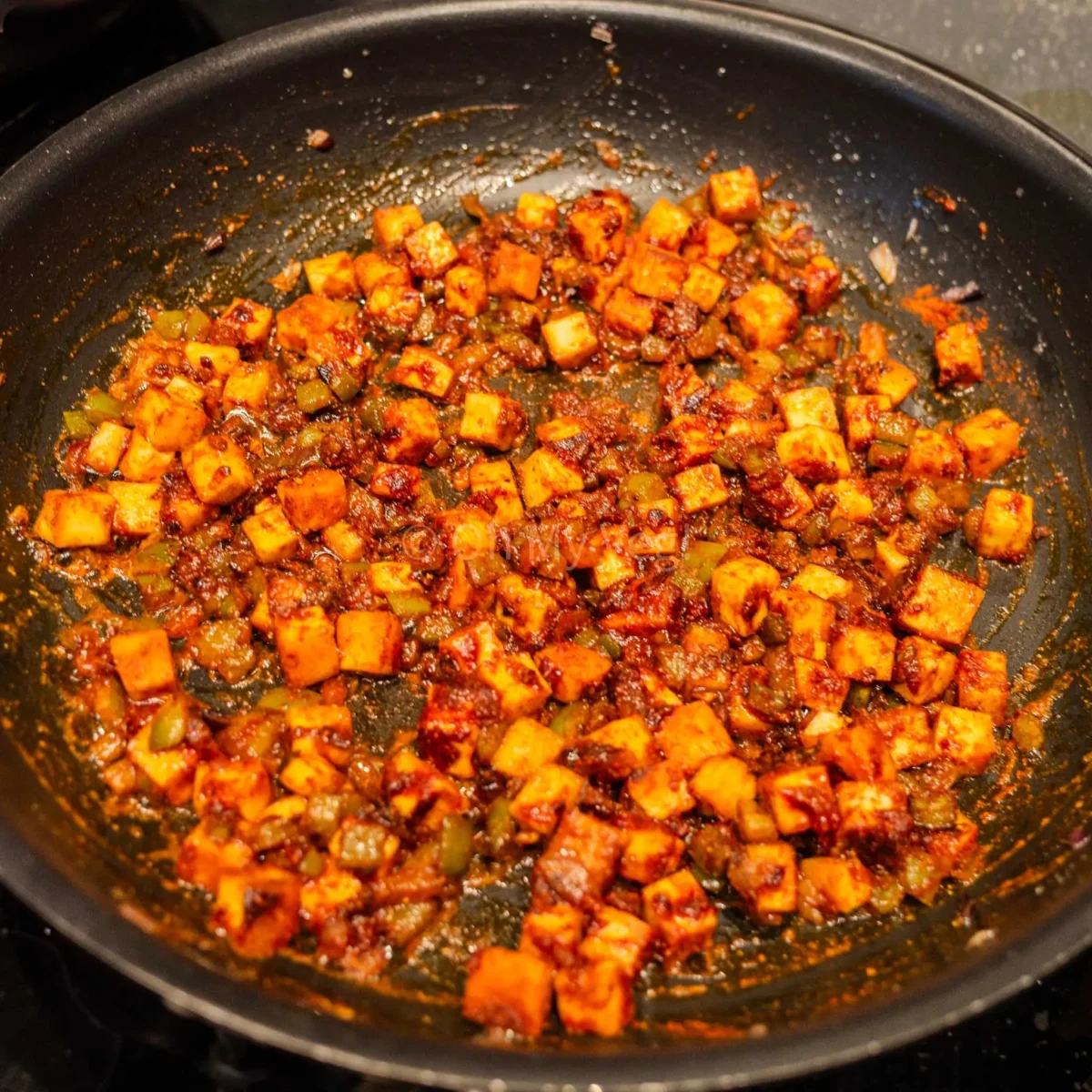
Seven: Coat the mixture in the spices and fry until aromatic. Be careful not to burn.
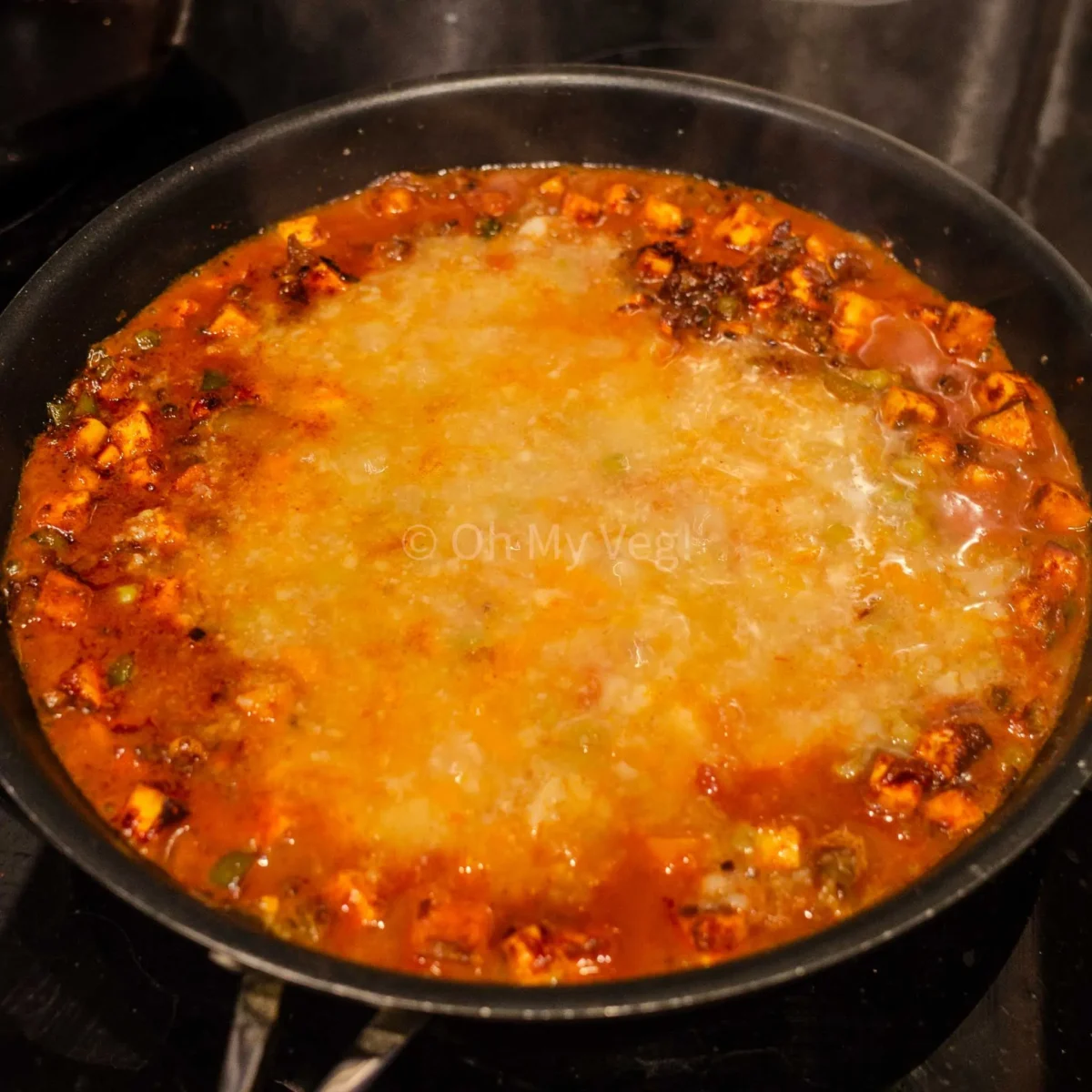
Eight: Add the mashed vegetables to the pan and mix well.
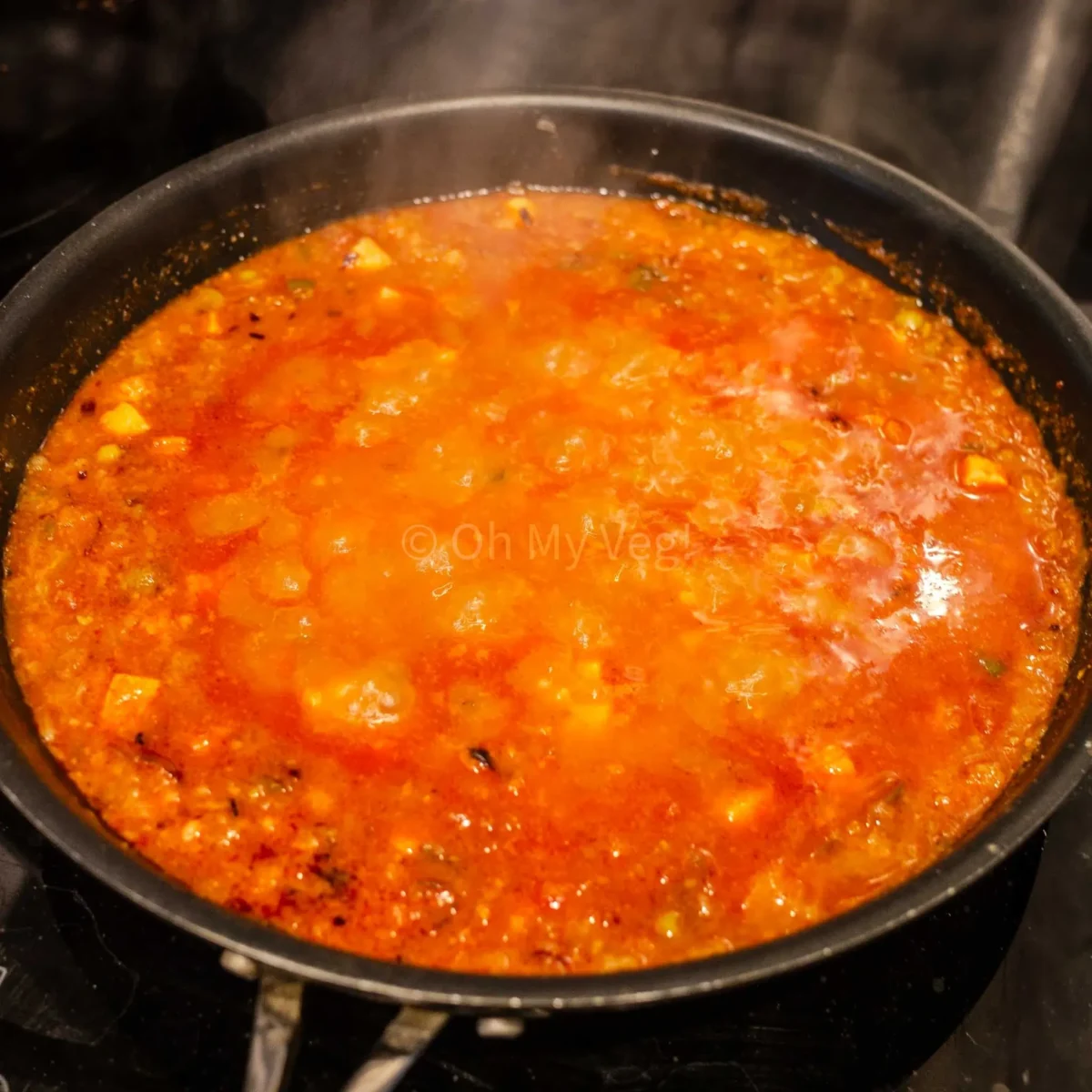
Nine: Gently simmer until the butter rises to the surface and the mixture thickens.
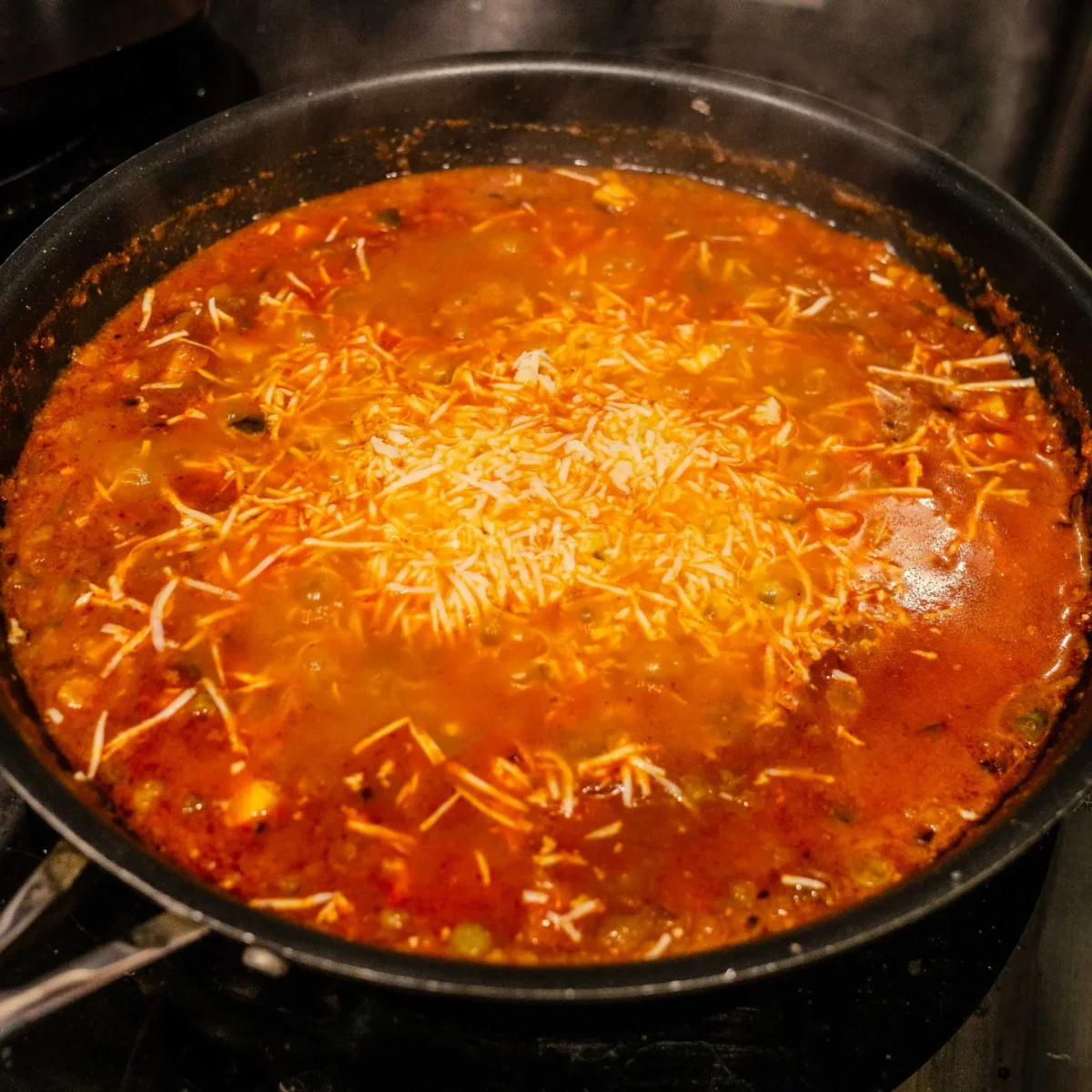
Ten: Add in grated paneer. Give the paneer pav bhaji a good mix, then serve.
Remember, the complete recipe (with ingredient quantities and instructions) can be found at the bottom of this page. You can also print the recipe, save the recipe, adjust the servings, and much more from there!
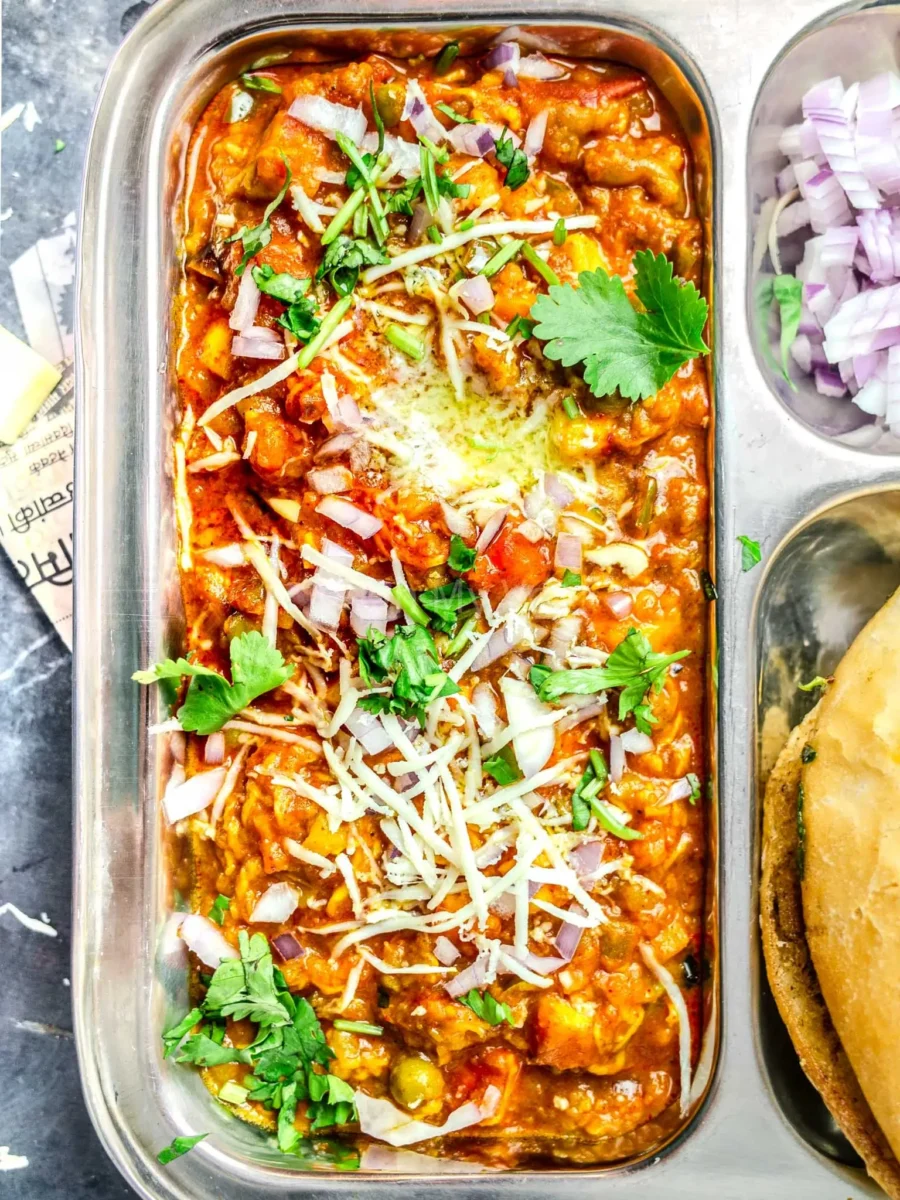
❄️ Storing Paneer Pav Bhaji
Whether you’re looking to make ahead (meal-preppers, I’m so envious of your organisational skills!), or simply make the most of leftovers, I’ve got you sorted.
Keep the paneer pav bhaji in an airtight container and refrigerate for up to three days. Reheat gently with a splash of water if needed, and garnish with fresh coriander (cilantro) to make your plate feel fresh again.
Paneer recipes generally freeze excellently, and paneer pav bhaji is no exception. Once cooled, store the dish in a freezer-safe, air-tight container for up to two months.
It’s best to thaw the dish overnight in the fridge, then reheat on the stovetop with a splash of water until piping hot. If you reheat directly from frozen, you run the risk of rubbery paneer and watery vegetables.
Pav is the only component of the meal that are best fresh. Once toasted, the bread rolls turn stale quickly.
🍞 Serving Suggestions for Paneer Pav Bhaji
I’ll be honest … nothing beats the classic way of digging into pav bhaji. Picture this: a traditional steel pav bhaji plate laden with that rich bhaji, finished with knobs of melting butter, plenty of chopped onions, fresh coriander, and a squeeze of lemon. You’ll need more onion and lemon wedges on standby, because it’s never enough (trust me). And, ready to scoop it all up, your buttery-toasted pav on the side.
Sometimes, I like to grate over some fresh paneer, just to drive home that this is paneer pav bhaji, not the standard stuff.
Want to be a rebel? Spoon the paneer pav bhaji over steamed rice. There may be no pav in this equation, but it tastes just as delicious.
And talking of rebels … fusion-style! Why not spoon paneer pav bhaji over baked potatoes — a British dish with a twist! Top with extra melty grated cheese.
Or, combine Mexican with Indian food (after all, both cuisines are spice-heavy!) and use the paneer pav bhaji to stuff in quesadillas or crunch wraps. It’s an easy, cheesy lunch!
So, grab your masalas, warm your pans, and let’s make paneer pav bhaji that tastes like it came straight off a Mumbai street cart. Full printable recipe below.
If you tried this paneer pav bhaji — or any other recipe on my website — please leave a 🌟 star rating and let me know your thoughts in the ✍️ comments at the bottom of the page. Thanks for being a part of my community!
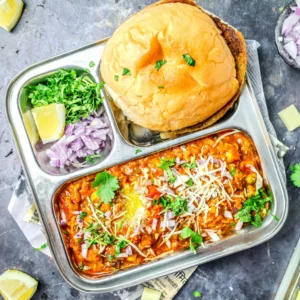
🧀 Paneer Pav Bhaji Recipe
Ingredients
For the Mashed Vegetables
- 220 g potatoes
- 80 g cauliflower
- 60 g carrot
- 200 g tomatoes
- 60 g green peas
- 600 ml water
For the Paneer Pav Bhaji
- 3 tablespoons butter
- 100 g onion finely chopped, 100g = ~1 large onion
- 1 teaspoon ginger garlic paste
- 80 g green bell pepper finely chopped
- 100 g paneer cubed
- 2 tablespoons pav bhaji masala
- 1 ½ teaspoon deggi mirch
- 1 ½ teaspoon red chilli powder
- ¼ teaspoon turmeric powder
- fine sea salt to taste
- 100 g paneer grated
- 2 teaspoon fresh lemon juice
To Garnish the Paneer Pav Bhaji
- 1 handful coriander cilantro, chopped
- red onion to taste, chopped
- 50 g paneer finely grated
- 4 knobs butter
For the Pav
- 8 pav soft bread rolls
- 2 tablespoons butter
Instructions
Cook the Vegetables
- Cut 220 g potatoes, 80 g cauliflower, 60 g carrot, and 200 g tomatoes to roughly the same size.
- Add the aforementioned vegetables to a pressure cooker along with 60 g green peas and 600 ml water. Set the pressure cooker over medium-high heat and cook for three whistles. Alternatively, add the vegetables and water to a large saucepan and boil for around 20 minutes.
- Once the vegetables have softened and the pressure has released, mash until mostly smooth with a potato masher or flat press*.
Make the Paneer Pav Bhaji
- Heat 3 tablespoons butter in a large saucepan (or very large tawa) over medium-heat heat.
- Once the butter melts, add 100 g onion (finely chopped) and 1 teaspoon ginger garlic paste. Fry, stirring occasionally, until the raw smell fades and both are aromatic.
- Add 80 g green bell pepper (finely chopped) and 100 g paneer (cubed) to the same pan. Fry for a few minutes, until the paneer has slightly browned on some sides, and the bell pepper has softened.
- Season the mixture with 2 tablespoons pav bhaji masala, 1 ½ teaspoon deggi mirch, 1 ½ teaspoon red chilli powder, and ¼ teaspoon turmeric powder. Stir to coat the paneer in the spices and cook for a few seconds, until no longer raw.
- Add the mashed vegetables to the pan along with fine sea salt to taste. Stir to mix well. Let the mixture cook for a few minutes, until the butter rises to the surface and the paneer pav bhaji has thickened.
- Stir in 100 g paneer (grated) and 2 teaspoon fresh lemon juice, then remove from the heat.
Cook the Pav
- In a large frying pan or flat tawa, heat 2 tablespoons butter over a medium flame until melted. Cut each of the 8 pav in half and place inside-down onto the butter. Fry gently until light golden.**
Garnish and Serve the Paneer Pav Bhaji
- When serving the paneer pav bhaji, garnish with 1 handful coriander (chopped), red onion (chopped), both to taste. Then top off each portion; split 4 knobs butter(1 knob each) and 50 g paneer (grated) between the plates.

